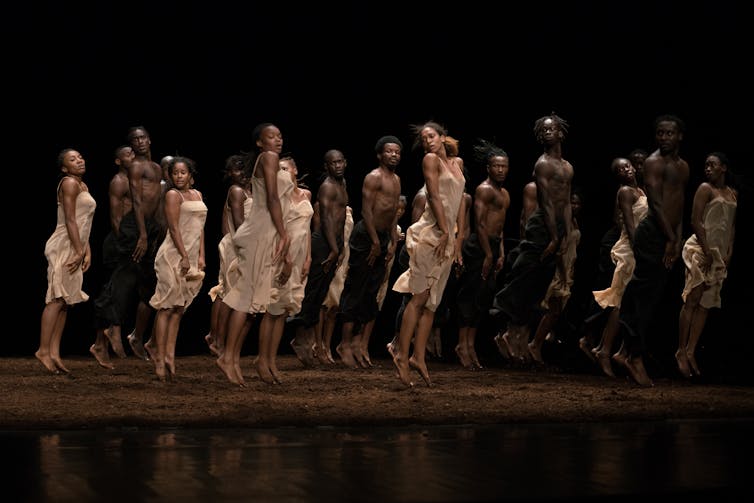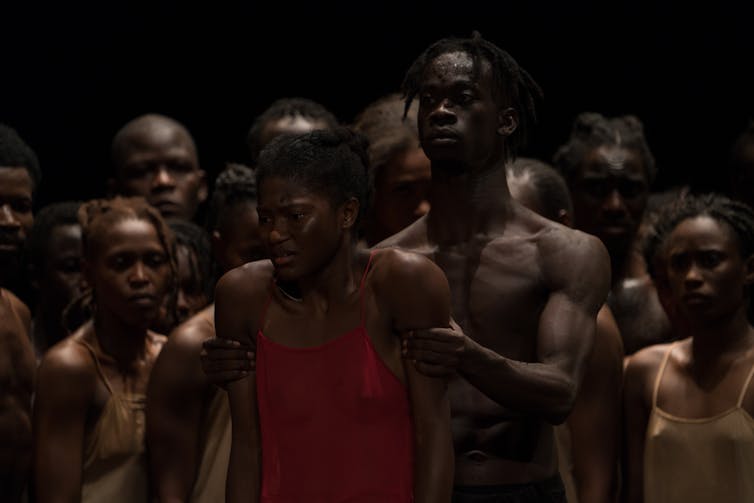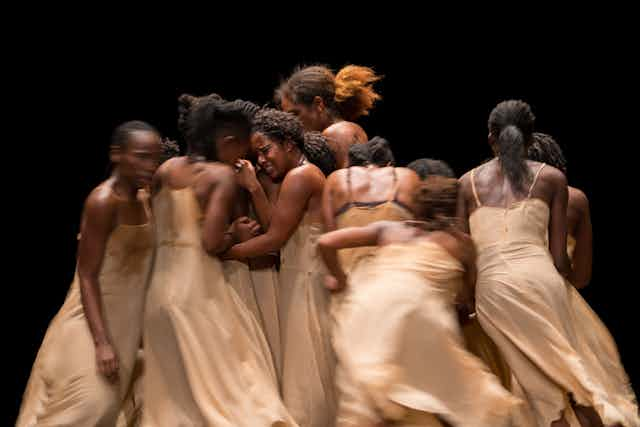At its premiere in 1913, Igor Stravinsky and Vaslav Nijinsky’s Rite of Spring shocked audiences and divided critics. The ballet centred around a straightforward yet brutal narrative – a community selects a sacrificial victim, a virgin who will be martyred to their fertility god to secure a good harvest. The plot, however, was not what scandalised Parisian theatregoers.
Every aspect of the performance transgressed western classical traditions. Stravinsky’s score re-imagined Russian folk music through a complex web of harmonies and constantly changing tempo. Nijinsky’s choreography abandoned ballet technique – his dancers had turned-in feet, curved spines and performed percussive stomps. And Nikolai Roerich’s set and costume designs were influenced by the folk art of Central Asia.
The ballet became a symbol of modernity, a bold vision of the future that was steeped in a global heritage.
Sixty years later, in the German city of Wuppertal, Pina Bausch’s version had a similar cultural impact, influencing generations of dancers to follow. Bausch’s remarkable staging covered the floor in a thick layer of soil, creating the impression of a devastated wasteland. Her intricate and relentless choreography required intense effort from the cast who, by the end, transformed the earth into a sweaty mud bath. The result was a visceral power play between men and women, a timeless morality tale about the consequences of misogynistic violence.
Bausch’s Rite was a great success and it became one of her best-known works. Throughout the four decades that she directed her radical independent company, Tanztheater Wuppertal, Bausch devised a new language of dance that departed from previous techniques and styles. The company diversified as it grew, taking in members from six continents, different generations and a much broader range of body types than is usually seen in the dance world.
After Bausch’s death in 2009, a foundation was established in her name, dedicated not only to preserving her legacy, but also expanding its reach. The Pina Bausch Foundation has authorised various dance companies to perform her work, including English National Ballet and Staatsballett Berlin. However, its collaboration with Senegalese choreographer Germaine Acogny offers a much more innovative approach.
For the first time, an ensemble has been created specifically for the purposes of dancing Bausch’s Rite of Spring. This staging, currently touring internationally, is performed by an all-African cast. Thirty-eight dancers from 14 countries breathe new life into now canonical choreography. Crucially, they also highlight the ongoing lack of African representation on theatrical stages.
Modern dance is global
From its very beginnings, modern dance has drawn inspiration from – and, too frequently, appropriated – cultures across the globe. American pioneer of modern contemporary dance, Isadora Duncan (1877-1927) referenced the philosophy and aesthetics of ancient Greece. The German pioneer of expressionist dance and dance therapy, Mary Wigman (1886-1973), was fascinated by the theatre and dance traditions of Asia. And American choreographer Martha Graham (1894-1991) incorporated Native American rituals into her works.

Yet there is a more complex history exemplified by artists such as Michio Ito (1892-1961), a Japanese dancer whose performances garnered the appreciation of audiences across Europe and the US, Uday Shankar (1900-1977), an innovator of Indian modern dance and Katherine Dunham (1906-2006), who researched traditional dances of the Caribbean.
Modern dance has always been global. Yet a problem with representation persists – and African dancers remain especially marginalised both on stage and in dance writing. The erroneous belief that modern dance has simply failed to take hold in the African continent erases a rich creative legacy.
A unique collaboration
Germaine Acogny and Pina Bausch’s careers ran in parallel. Both women studied abroad before bringing their expertise back to their home countries. Acogny caught the attention of Senegalese president, Léopold Sédar Senghor, who sent her to work with the acclaimed choreographer Maurice Béjart in Belgium.
Senghor and Béjart helped her to establish Mudra Afrique, the first school of contemporary dance in Senegal’s capital city, Dakar. However, Acogny became increasingly frustrated by the curriculum’s focus on western techniques and her desire to create a home for African modern dance led her to open École des Sables in 2004.

This seaside dance school was the locus for the Rite of Spring ensemble, who rehearsed with members of Bausch’s company for months to get under the skin of her choreography. Original touring plans were put on hold due to the pandemic. Thankfully, a visiting documentary filmmaker captured a final rehearsal on the beach at Toubab Dialaw, immediately before the country went into lockdown.
The resulting film reached global audiences at a time when live theatre seemed a distant prospect and, for many, was an important introduction to the culture of modern dance in Africa.
The company’s performances have brought rave reviews, including a sold-out run at the 2023 Edinburgh International Festival. Nonetheless, this raises a complex question. After a century of cross-cultural exchange and the global expansion of the art form, should it take a western “classic” to raise the profile of African modern dance? Sincere reflection is required on the power structures that govern dance as a global enterprise and determine whose work ends up being seen.

Looking for something good? Cut through the noise with a carefully curated selection of the latest releases, live events and exhibitions, straight to your inbox every fortnight, on Fridays. Sign up here.

